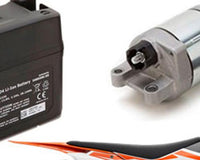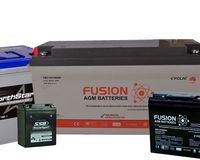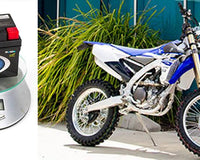Batteries can be pretty complicated. If someone asked you what the difference between the HVT-1 and HVT-8 was, you probably wouldn’t be able to tell.
There are so many little things that can make a huge difference between two lead acid batteries and trying to find specific and simple information on batteries can be like finding a needle in a haystack.
We’ve made this list of battery basics to help break down lead-acid batteries for you.
Structure
Lead acid batteries are made up of plates, lead and lead oxide and an electrolyte solution which creates the chemical reaction that gives us electrons. The reason why batteries can be so heavy is due to the fact that they’re packed to the brim with lead, and more lead means they have a greater capacity.

Starting and Dual Purpose, what’s the difference?
There are two types of lead-acid batteries: starting and deep cycle. Starting batteries are designed to give out quick bursts of energy for starting, lighting and ignition (which is why they’re also known as SLI batteries ). They have more plates, which are thinner and have a different metal composition.
Deep Cycle batteries, on the other hand, are designed for long-term energy, rather than instant delivery. Unlike SLI’s, they have thick plates to handle more discharge cycles, which allows them to last longer.
There are also Dual-Purpose batteries on the market, which can be used for both starting and deep cycle applications.
Wet Cell, Gel Cell and Absorbed Glass Mat (AGM) – what’s the difference?
These are the three variations of lead acid batteries. Wet cells come as serviceable or maintenance free, the serviceable batteries are beneficial as you can add water and check the electrolytes with a hydrometer.
Wet Cell batteries are much cheaper than Gel Cell and AGM batteries, but there’s a reason for this. Gel cell and AGM batteries have a longer shelf life and are more durable, so they can last for longer periods of time in storage without declining in quality or losing charge.
AGM batteries are also known as dry cell, non-spillable or valve regulated lead-acid batteries. AGM batteries are generally the preferred battery type over Gel Cells.
as is the case with nay battery, you get what you pat for. The more you pay, the better off you'll be.
Testing your battery
In order to test your battery, measuring the gravity or battery voltage are the most accurate ways of doing so. Temperature-compensating hydrometers are the best way to measure gravity, and Digital D.C. Voltmeters are the best way to measure Voltage.
First, you charge the battery to its full capacity and then remove the surface charge. If the battery has been sitting at least 12 hours, you can start testing it. To remove the surface charge, the battery must be drained for roughly ten minutes. A high beam headlight is great for this. After turning off the light, you’re ready to test the battery
Maintaining your battery
It is important to look after your battery like it’s your firstborn. Well maybe pay a bit more attention to the kid, but it’s pretty important to make sure you properly maintain your battery too.
- It’s important to clean and tighten the cable connection as loose connections can often be the cause of battery issues.
- Make sure you clean your battery with a baking soda and water solution. Six tablespoons of baking soda and a glass of water are usually enough.
- If you own a serviceable battery, make sure you check the fluid level. Make sure you use distilled, mineral-free water as it is free of any bacteria or harmful germs that could cause damage to your cells.
- Avoid overfilling your battery cells. The natural fluid expansion can push excess electrolytes from the battery, especially in hot weather.
- To stop the cables on your top-post batteries from corroding, use a small drop of silicone sealer at the base of the post and place a felt battery washer over it. Coat the washer with high-temperature grease or petroleum jelly (Vaseline), then place cable on the post and tighten. Coat the exposed cable end with the grease.









